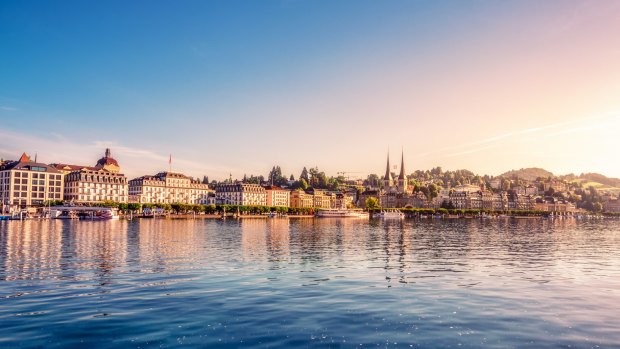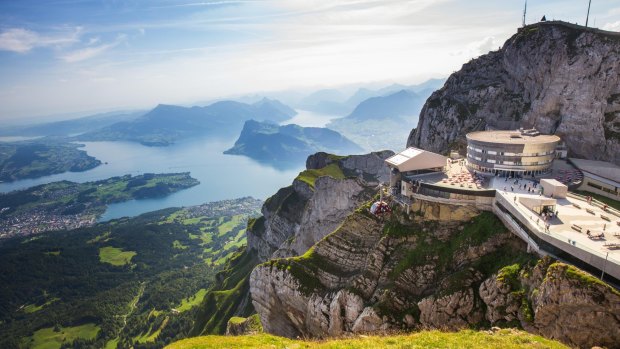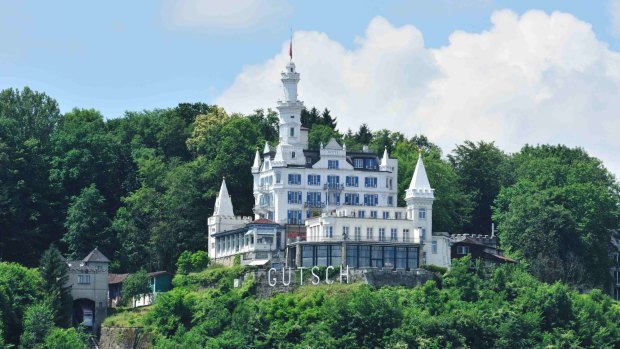This was published 4 years ago
The Swiss know how to put their personal fortunes to good use

Lucerne and its famous lake.Credit: Getty Images
Casting a mirror image across its lake, overshadowed by the peaks of Mount Pilatus and Rigi, the city of Lucerne is where every Swiss cliché finds its feet.
Geraniums spill from its window boxes; restaurants with half-timbered facades dish out rösti potatoes and Zurich-style veal with mushrooms. Church spires and bell towers dominate the skyline; there's a watch shop on every corner; and in the Altstadt – the old town – cobblestoned laneways squirm into squares ringed by frescoed burgher's houses. Among the evening's entertainments is a performance of yodelling and flag throwing at the Stadtkeller, although none of the performers take up a crossbow and call for volunteers.
Lift the lid on this chocolate box to discover a compact city of real charm, with a lively cafe culture, a fine museum of art and a robust taste for the great outdoors. The best way to take it in is with a gentle stroll. Walk along the Museggmauer, the 14th-century city walls, with panoramic views from its watchtowers that still protect the north side of the Altstadt.

The view from Mount Pilatus, accessible via the world’s steepest cogwheel railway.Credit: Eva Bocek / Alamy Stock Photo
Lucerne ladders the Reuss River with bridges, the most famous of which is the Kapellbrücke, the Chapel Bridge, a 205m-long paradigm of the carpenter's art. The 1333 original burned down in 1993, but the replacement is an exact replica. Midway across the bridge, the medieval Wasserturm – the water tower – is the city's favourite icon.
Lake Lucerne is cradled by forests that rise into bald mountains dusted with snow well into summer, its foreshores discreetly dotted with the mansions of the rich and merely famous, including the 15th-century country home where Richard Wagner once lived. A trip along the lake takes you through a string of postcardperfect vistas and the way to see it is on one of the glorious belle epoque paddle steamers that have been carving the lake's waters for the past 100 years.
Buried in forest high above the city, Chateau Gütsch is a castle hotel cast from the same fairy-tale mould as Mad King Ludwig's Neuschwanstein in Bavaria. The terrace also happens to have the most beautiful view over Lucerne. Served between 2pm and 6pm, the Mediterranean-style afternoon menu is perfect for alfresco dining. Book a table close to the edge, and leave room for the artsy Toblerone dessert with mousse and berries. Take the Gütsch Funicular up to the hotel from Lucerne's Baselstrasse: the staircase is an absolute slog.

The fairytale Chateau Gütsch.
The Swiss might know how to spin the wheels of commerce but you have to admit they put their personal fortunes to good use. Art dealer Siegfried Rosengart was a big player in the 20th-century art world, counting among his friends some of the greatest artists of the era. After his death, his daughter, Angela, established the Rosengart Foundation to display his private collection and in 2002 the Sammlung Rosengart Museum opened, housed in a former bank. It's a judicious survey of some of the greatest names ever to have laid hands on brush, pencil and charcoal over the past two centuries: Renoir, Matisse, Monet, Miro, Kandinsky and Chagall. There's a notable collection of 32 artworks by Picasso, mainly from his late period, and – in the basement – 125 resonant watercolours, drawings and oil paintings by Switzerland's own Paul Klee.
Being Swiss, it's only natural that there's an engineering marvel somewhere in the picture. Here, it's the world's steepest cogwheel railway that hoists you up to the heights of Mount Pilatus. It begins at Alpnachstad, which you can reach by railway or bus from Lucerne in 20 minutes. Better still, take the lake steamer to Alpnachstad, a honey of a ride along the edge of the lake.
The ride aboard the mountain railway takes just 40 minutes and it's a hoot; a bright red carriage glides through forests and tunnels and into sharp ridgeback hills that give the mountain its reputation as the lair of dragons.
The railway was built more than 100 years ago; before that, donkeys would haul travellers on the grand tour up the mountain, including Queen Victoria, who summitted with the assistance of a pony named Flora. A sketch by her daughter Princess Louise shows the Queen riding sidesaddle up the steep track under a parasol, her kilted Scottish manservant, John Brown, steadfast at the bridle. The Queen is remembered in the suitably frou-frou Restaurant Queen Victoria in the Hotel Pilatus-Kulm near the summit.
From the cogwheel railway's top station, the walk to the 2128-metre peak, the Tomlishorn, takes less than 30 minutes, with heart-stopping scenery along the clifftop path. Yodel if you please. Take the Dragon Ride cableway back down the mountain to Frakmuntegg followed by the panoramic gondola to Kriens from where a short bus ride returns you to Lucerne's lakefront.
The culinary arts do not come naturally to the Swiss. In a country surrounded by Italy, France, Germany and Austria, this is nothing short of astonishing, but the dining scene in Lucerne is a happy exception. I found myself one evening at Mill'Feuille, a busy bistro with outside tables, the warm light of a setting sun on my face, a fountain by my side and the River Reuss gurgling in the background, dining on poached char moistened with a buttery sauce with wild rice, baby spinach and a green salad, and a glass of Austrian wine.
On the other side of the Spreuer Bridge, in the courtyard in front of the Jesuit Church, was a ring of 18 men and women playing alpenhorns. The soft, crooning sound of an alpenhorn is probably the gentlest sound you'll ever hear, and I walked back to my hotel with the melody echoing through the darkening streets, in a state of almost unbearable happiness.
This article appears in Sunday Life magazine within the Sun-Herald and the Sunday Age on sale July 21.
Sign up for the Traveller Deals newsletter
Get exclusive travel deals delivered straight to your inbox. Sign up now.